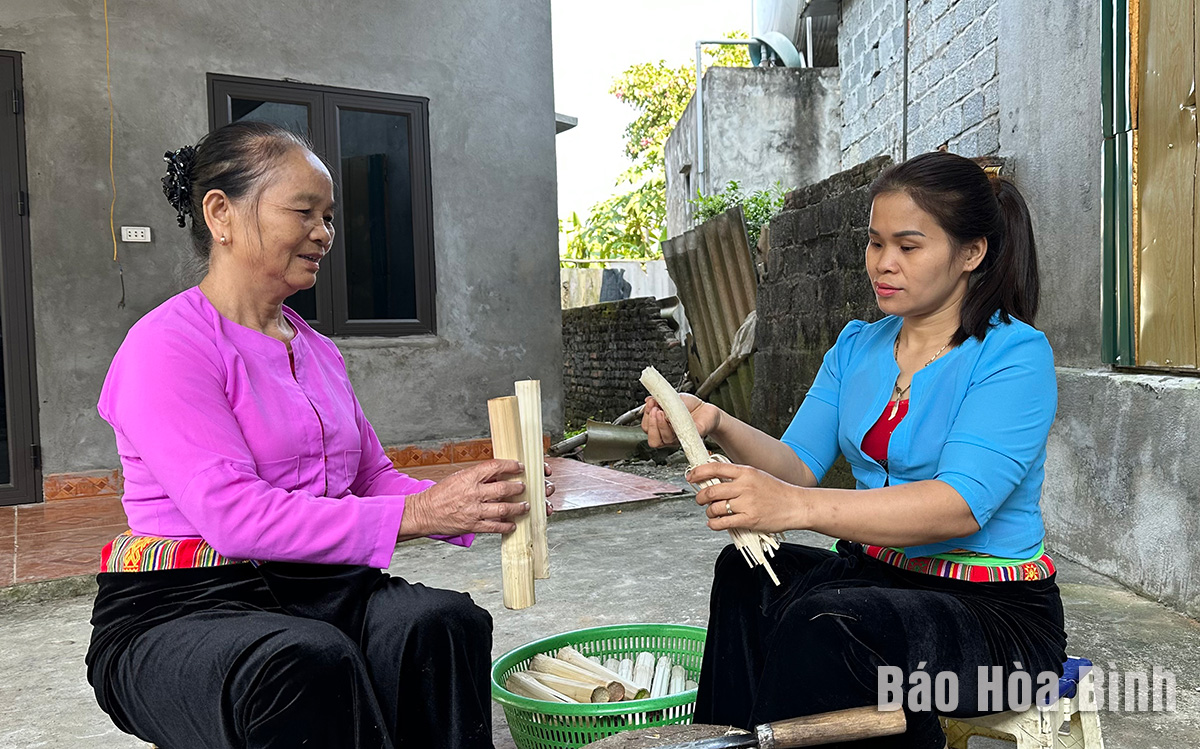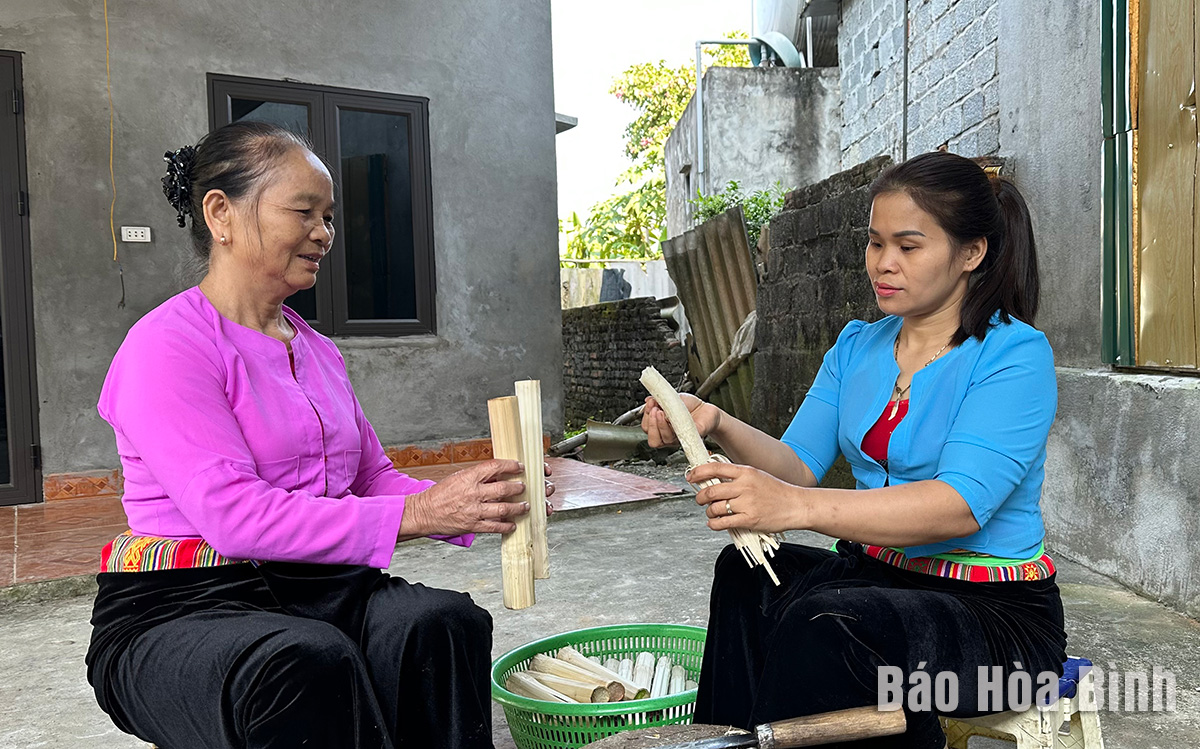
Beyond being a local staple rated as a three-star OCOP product, com lam (steamed sticky rice in bamboo pipes) has been imbued with the culture of the Muong Dong ethnics who believe that com lam is an accomplishment of the locals after a hard working year, and an indispensable delicacy to tickle Tet holiday taste buds.
Photo: Locals in Mo Da residential area, Bo town, Kim Boi district, develop Muong Dong com lam into a three-star OCOP product.
The quintessence of Muong Dong
In order to create the distinctive flavour of com lam, Muong Dong people meticulously select ingredients, with large and milky white glutinous grains preferred. The rice is soaked for about 8-12 hours before being rinsed thoroughly and mixed with a pinch of salt and finely chopped coconut flesh. It is then tightly packed into bamboo tubes and filled with water up to the brim.
As for bamboo tubes, they should be 35-40 centimetres long, cut from fresh and sturdy bamboo trees which are not too old or too young to avoid the rice from drying out or getting burnt.
The rice tubes must be roasted over charcoal between 45 and 50 minutes, and rotated every 15 minutes until they are fragrant.
Com lam could be served with grilled pork, chicken, minced fired pork and pickled bamboo shoots; however, it offered the best taste when paring with muoi vung (minced roasted peanuts, sesame and salt).
According to Dinh Thi Ly, a resident in Mo Da who has considerable experience in making com lam, the secret to making tender and fragrant com lam lies in the glutinous rice grown in mineral-rich water land, and the cook’s experience.
In the Muong customs, men are responsible for preparing meals. However, when it comes to com lam, all people are adept at making it. Com lam has been an integral part of the locals’ daily life and become a unique feature of the Muong culture.
Making com lam reach far and wide
There are currently over 30 households in Mo Da residential area making com lam. To meet market demands, they have worked to improve the production process while still preserving its traditional essence. Along with enhancing product quality, they have focused on improving the product’s packaging and labelling them with origin-tracing stamps. Besides, all products are vacuum-sealed for better preservation. Currently, Muong Dong com lam is served at restaurants and put on sale at supermarkets in many provinces and major cities nationwide.
Pham Hong Son, an owner of Muong Dong com lam production establishment, said his family sells up to 8,000 com lam tubes each month to the market, each valued at 7,000-8,000 VND (0.29-0.33 USD).
As part of the efforts to develop the brand of Muong Dong com lam, locals want to set up a cooperative to gradually complete procedures to develop geographical indication, further improve product quality, and expand market for the staples, he added.
Com Lam not only enriches the culinary culture of the Muong Dong people but also contributes to promoting the Muong culture to tourists and those interested in exploring the traditional cuisine. The lives of the people in Muong Dong have undergone many changes, but com lam remains an indispensable traditional dish, and a gift that is spotlighted at festivals, fairs, and events.
With an increasingly vibrant and widespread emulation movement aimed at building cultured residential areas and cultured families, Yen Thuy District has been making steady progress toward improving both the material and spiritual well-being of its people, while fostering a civilized, prosperous, beautiful, and progressive community.
Once lacking recreational spaces and community facilities, Residential Group 2 in Quynh Lam Ward (Hoa Binh City) has recently received attention for the construction of a new, spacious, and fully equipped cultural house. The project followed the model of state support combined with public contributions in both labor and funding.
The "All people unite to build cultural life" movement, which has been effectively integrated with Kim Boi district’s socio-economic development goals, is fostering a lively spirit of emulation across local residential areas, hamlets, villages, public agencies, and enterprises. In addition, through the initiative, traditional cultural values are being preserved and promoted, while community solidarity and mutual support in poverty reduction and economic development are being strengthened.
A working delegation of the Hoa Binh provincial People’s Committee led by its Permanent Vice Chairman Nguyen Van Toan on June 11 inspected the progress of a project to build the Mo Muong Cultural Heritage Conservation Space linked to tourism services in Hop Phong commune, Cao Phong district.
Born and growing in the heroic land of Muong Dong, Dinh Thi Kieu Dung, a resident in Bo town of Kim Boi district, in her childhood was nurtured by the sweet lullabies of her grandmother and mother. These melodies deeply imprinted on her soul, becoming an inseparable part of her love for her ethnic group's culture. For over 20 years, this love for her hometown has driven Dung to research, collect, and pass down the cultural values of the Muong people to future generations.
In the final days of May, the Ethnic Art Troupe of Hoa Binh Province organized performances to serve the people in remote, mountainous, and particularly disadvantaged areas within the province. These were not just ordinary artistic shows, but they were the meaningful journeys aimed at spreading cultural values, enhancing the spiritual life of the people and contributing to the preservation of ethnic minority cultural identities.



